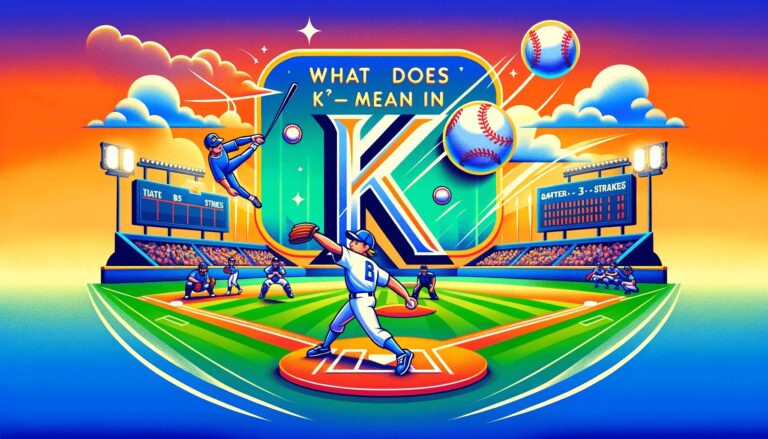What Does TB Mean in Baseball Stats?
If you’re wondering “What does TB mean in baseball,” you’re not alone. ‘TB’ stands for Total Bases, a fundamental statistic that sums up a player’s offensive contributions by assigning a value to each hit – singles, doubles, triples, and home runs.
Understanding Total Bases is crucial for gauging a player’s hitting power and overall impact in the game. Read to explore why TB matters to players, teams, and fans alike.
Key Takeaways
- Total bases (TB) is a significant baseball statistic that measures the number of bases a player gains from hits, with singles, doubles, triples, and home runs valued at one, two, three, and four bases respectively.
- This statistic is exclusive to bases earned from hits and does not include bases gained from walks or errors, making total bases a clear indicator of offensive prowess and contribution to the team’s success.
- Historical records of total bases, such as those held by Hank Aaron and Babe Ruth, underscore the importance of this metric in evaluating player performance and its impact on the game over time.
Exploring TB: The Essence of Total Bases in Baseball

When perusing the baseball almanac, the player’s total bases is a batting statistic that often catches the eye.
It signifies the number of bases a player gains through hits, offering a glimpse into their offensive skills.
But, how does one calculate these total bases? Each type of hit, whether a single, double, triple or a home run, carries a value.
Here is the value for each type of hit:
- A single is worth one base
- A double is worth two bases
- A triple is worth three bases
- A home run, the most coveted of all, is worth four bases.
Adding these values over a period (a game, a season, or even a career) gives us the player’s total bases which, in turn, lets us assess their overall hitting prowess and contribution to the team.
Hence, when the crowd erupts for a home run next time, bear in mind that it isn’t solely about the immediate score.
It’s also about the four total bases added to the hitter’s record, enhancing their standing in the baseball reference books and providing a more nuanced view of their performance.
Understanding Hits and Their Value
In the realm of baseball, a hit carries more significance than it appears. It can be:
- a single
- a double
- a triple
- a home run
Each carrying a specific value in terms of total bases. Imagine the batter standing at home plate, heart pounding, waiting for the pitch.
The ball is thrown, the bat swings, and there’s contact. The batter sprints to first base, but it’s not just a run. It’s a single and adds one to the player’s total bases.
A double, where the batter makes it to the second base, adds two to the total bases count. A daring run to the third base results in a triple and adds three to the total bases.
And finally, the crowd-pleasing home run, where the batter completes a full circle and returns to the home plate, adds four to the total bases.
These values directly reflect the number of bases a player advances on the play where the hit takes place.
The Significance of Total Bases for Players and Teams
Despite the intoxicating fan cheers and exhilarating gameplay, baseball fundamentally remains a game of numbers.
One of these numbers, the player’s total bases, is a significant measure of their offensive contributions.
Unlike other statistics, a player’s total bases focus exclusively on the bases gained from hits – singles, doubles, triples, and home runs – without considering bases gained from walks or by following batters.
It’s all about the player and their bat, and the distance they cover with their hits.
This unique focus makes total bases a valuable statistic in the baseball almanac. It’s not just about who has the most total bases or who hit the most home runs.
It’s about understanding a player’s offensive productivity and their impact on the game.
So, every time a player steps up to the plate, they’re not just playing for the run. They’re also playing for their total base count, adding a layer of strategy and depth to the nine innings of the game.
Read Also: What Does MRP Mean in Baseball
Calculating a Batter’s TB: A Step-by-Step Guide
Ever pondered the calculation of batting statistics in a baseball reference book? Specifically, how do they calculate a batter’s total bases? Well, it’s easier than you might think.
The calculation of total bases takes into account only the bases earned directly from hits such as:
- singles
- doubles
- triples
- home runs
and not from any other means like walks or errors. Each type of hit is assigned a specific value: a single is worth 1 base, a double 2 bases, a triple 3 bases, and a home run 4 bases.
To determine a player’s total bases, these values are added together. The number of singles is added to twice the number of doubles, thrice the number of triples, and four times the number of home runs.
For example, consider a player who hits 2 singles, 1 double, and 1 home run in a game. Their total bases would be calculated as: (2 x 1) + (1 x 2) + (1 x 4) = 8 total bases.
This simple yet effective calculation gives us a snapshot of the batter’s offensive performance in the game.
From Bat to Base: Scoring Singles to Home Runs
Every hit counts across the nine innings of a baseball match. But not all hits are created equal. Baseball categorizes hits into four main types: singles, doubles, triples, and home runs.
The moment the bat connects with the ball, the type of hit is determined, and this directly affects the player’s total bases.
Each hit type is assigned a point value: one point for a single, two points for a double, three points for a triple, and four points for a home run.
This progressive point value system makes home runs the most valuable hits, not just in terms of the immediate score but also in terms of total bases.
A home run not only sends the crowd into a frenzy but also adds four to the player’s total bases, making it a game-changing event.
So, the next time a batter steps up, remember, they’re not just playing for the score. They’re also playing for their total bases, adding a strategic layer to every swing of the bat.
Adding It All Up: The Math Behind the Stat
As we further probe the universe of baseball statistics, it’s time to uncover the mathematical logic behind total bases.
The formula to calculate total bases is TB = 1B + 2x2B + 3x3B + 4xHR, where 1B represents singles, 2B doubles, 3B triples, and HR home runs.
This formula might look complex at first glance, but it’s quite straightforward when you consider the concept of total bases divided.
Let’s take an example to understand this better.
Imagine a player who has hit:
- 73 singles
- 36 doubles
- 9 triples
- 54 home runs
To calculate their total bases, we would use the formula as follows: 73×1 + 36×2 + 9×3 + 54×4, which equals 388 total bases.
This number reflects the player’s offensive productivity for the season, giving us an insight into their performance that goes beyond just their batting average.
Hence, when you glance at the stats next time, bear in mind that it’s more than just a numbers game.
It’s about the stories they tell, the performances they reflect, and the g games they change, including those exciting gf games.
Read Also: What Does AB Mean in Baseball
Historical Highs: Record-Holding TB Achievements

Having grasped what total bases are and their calculation, it’s time to acknowledge the players who have left an indelible mark on this specific statistic.
Individual achievements in total bases are recognized in records for:
- Career
- Single-season
- Single-game
- Postseason performances
At the pinnacle of these records sits Hank Aaron, who holds the all-time MLB record for career total bases with a whopping 6,856.
These records serve as a testament to the players’ exceptional performances and their ability to consistently deliver high offensive productivity. They also highlight the importance of total bases in evaluating a player’s performance.
After all, it’s not just about hitting the ball. It’s about how far the ball goes, how many bases are covered, and how often this is achieved.
So, let’s delve deeper into these records and relive some of the most memorable moments in MLB history.
Single-Season and Career TB Kings
When recounting MLB history, two names synonymous with extraordinary performances in total bases are Hank Aaron and Babe Ruth.
Hank Aaron, an icon of the sport, holds the record for the most career total bases with an astounding 6,856. This record is a testament to Aaron’s consistent offensive productivity throughout his career.
On the other hand, Babe Ruth, often regarded as one of the greatest baseball players of all time, holds the record for most total bases in a single season.
In 1921, Ruth achieved 457 total bases, setting a record that still stands in the American League.
The National League record for total bases in a single season is held by Rogers Hornsby, who achieved 450 total bases in 1922.
These records highlight the significance of total bases in evaluating a player’s performance and their impact on the game.
Memorable TB Moments in MLB History
Achieving a high count of total bases in a single game is considered a rare and remarkable accomplishment in baseball.
It’s these performances that become etched in the annals of MLB history, making the players legends in their own right.
One such performance was by Shawn Green, who set the National League single-game total bases record with 19.
Playing for the Los Angeles Dodgers, Green achieved this feat in a game against the Milwaukee Brewers on May 23, 2002.
In the American League, the record for total bases in a single game is held by Josh Hamilton.
Hamilton achieved 18 total bases while playing for the Texas Rangers in a game against the Baltimore Orioles on May 8, 2012.
These memorable moments are a testament to the offensive prowess of these players and the significance of total bases in shaping the outcomes of games.
Read Also: What Does K Mean in Baseball
Impact of Total Bases on Game Outcomes

As we have observed, total bases extend beyond being a mere statistical measure. They have a direct impact on the outcome of games.
Players who excel in clutch situations through key hits can add significantly to the total base count, leading to important scoring innings which may change the game’s result.
High total base counts can turn potential losses into come-from-behind victories, making them a crucial factor in the game’s dynamics.
It’s not just about the player hitting the ball. It’s about the bases they cover, the runs they score, and the momentum they create.
Every single, double, triple, and home run contributes to the total bases, changing the course of the game.
So, the next time you’re watching a game, keep an eye on the total bases. They might just be the game-changer.
Clutch Hits and Rallying Innings
Certain moments in baseball are pivotal, determining the game’s outcome. These are the clutch situations where a player’s performance can dramatically shift the momentum and outcome of the game.
A well-timed hit can lead to substantial scoring in an inning, altering the pace and strategy of the game.
High total base counts from these clutch hits often contribute to these rallying innings, turning potential losses into come-from-behind victories.
The ability to deliver clutch hits that lead to high total base counts is essential in determining a team’s success in tight, competitive games.
So, the next time you see a player stepping up to the plate in a critical situation, remember, it’s not just about the hit or the sacrifice hits.
It’s about the total bases they can accumulate and the impact they can have on the game’s outcome.
The Correlation Between TB and Winning Percentages
Whether you’re a baseball enthusiast or an aspiring sabermetrician, the correlation between total bases and winning percentages might pique your interest.
An increase in a team’s total bases is associated with a higher probability of winning games.
This correlation is a testament to the importance of offensive productivity, as the accumulation of total bases plays a key role in a team’s ability to score runs, which is a direct contributor to winning games.
Total bases are a component of slugging percentage (SLG), a team success metric that correlates with higher winning percentages in Major League Baseball.
Regression analyses indicate that higher slugging percentages, which include total bases, contribute positively to win percentages for baseball teams.
So, the next time you’re analyzing a team’s performance, don’t just look at their win-loss record. Take a closer look at their total bases, and you might just find the key to their success.
Read Also: What is RPI in Baseball
Beyond the Box Score: TB in Advanced Analytics
In modern-day baseball, the prominence of analytics in comprehending player performances and outcomes is ever-increasing.
This is where sabermetrics come into play, using total bases among other metrics to evaluate player performances.
Total bases are often combined with metrics like slugging percentage and on-base plus slugging (OPS) for a more nuanced assessment of a player’s contribution to the offense.
The advancement of baseball analytics has moved beyond traditional stats such as batting averages.
Today, metrics that encompass total bases provide a fuller understanding of a player’s value, giving insights into their offensive productivity that go beyond just the number of hits or runs.
So, the next time you’re delving into the world of baseball analytics, remember to consider total bases.
They might just provide the insights you’re looking for, and understanding what total bases refer to can enhance your analysis.
TB and Sabermetrics
If you’re an aficionado of baseball analytics, you’re likely acquainted with the term ‘sabermetrics’.
This field of analytics uses total bases to calculate a player’s slugging percentage, which is achieved by dividing a player’s total bases by their number of at-bats.
But total bases don’t just stop at contributing to slugging percentage. They are utilized within various advanced metrics to quantify a player’s hitting ability and overall offensive impact, moving beyond traditional statistics like batting average.
Scouts and front offices incorporate total bases into player evaluations. Along with other statistical measures, total bases are used to gauge a player’s offensive capabilities and their value to the team.
So, whether you’re a fan trying to understand your favorite player’s performance or a scout evaluating a potential recruit, remember to consider total bases.
They’re not just a number, but a measure of a player’s potential to change the game.
Integrating TB Into Player Evaluations
Player evaluations hold paramount importance in the sphere of baseball. They determine the composition of teams, the strategies of games, and often, the outcomes of seasons.
One of the metrics that play a key role in these evaluations is total bases. These provide insights into a player’s offensive productivity and are used by scouts and front offices in assessing the player’s skill level.
Whether it’s the scouts watching a college game or the general managers planning their team’s next season, total bases are an integral part of their evaluation process.
By considering them among various statistical measures, they gauge a player’s offensive capabilities and their potential to contribute to the team.
So, the next time you’re debating a player’s performance or potential, don’t forget to consider their total bases. They could be the difference between a good player and a great one.
See Also: What Does ERA Mean in Baseball
Conclusion
In conclusion, “TB” in baseball stands for “Total Bases.” It’s a simple stat that adds up all the bases a batter reaches through hits.
It gives a quick idea of a player’s hitting power without getting too complicated.
So, when you see “TB” in baseball stats, just think about how many bases the player has gained with their hits.
Frequently Asked Questions
What are total bases in baseball?
Total bases in baseball are a measure of a player’s offensive productivity, calculated by adding the player’s bases earned from hits. Different hits have different values, such as singles being worth one base, doubles worth two bases, triples three bases, and home runs four bases.
How are total bases calculated?
Total bases are calculated by adding the number of singles, twice the number of doubles, three times the number of triples, and four times the number of home runs. This method provides a comprehensive measure of a player’s offensive performance.
Who holds the record for the most career total bases in MLB history?
Hank Aaron holds the record for the most career total bases in MLB history with 6,856 total bases.
What is the significance of total bases in a game’s outcome?
In baseball, high total base counts from clutch hits can lead to significant scoring innings and game-changing outcomes. This can contribute to substantial scoring and momentum shifts during the game.
How are total bases used in advanced baseball analytics?
Total bases are used in advanced baseball analytics, such as sabermetrics, to comprehensively evaluate player performances and outcomes.







